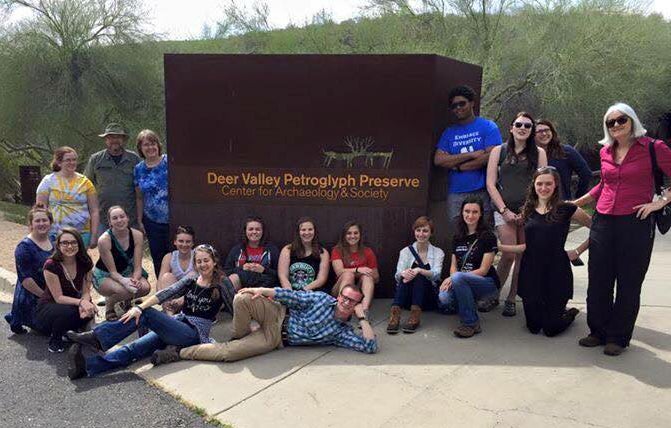Students travel to the Grand Canyon and beyond to connect chemistry and art
Published 12:00 am Thursday, March 24, 2016

- Catawba students took a trip to Arizona over spring break to study art and chemistry.
By Ashley Pierce
Catawba College
For college students across the country, spring break is a time to relax and have fun. Many travel to traditional spring break locations in pursuit of the same. For students of Catawba College’s Honors Program class, aesthetic alchemy, spring break was a chance to connect chemistry and art through a directed study on site travel opportunity.
Guided by Catawba Chemistry Chair Dr. Carol Ann Miderski and Visual Art Professor Ashley Pierce, students traveled to Arizona over their spring break. Travel components are an important part of Honors Program classes at Catawba and this one connected course content to travel by focusing largely on nature and art as well as local culture and history.
The trip began in Phoenix where students were guided through Deer Valley Petroglyph Preserve viewing petroglyphs archaeologists date to between 5,000 and 7,000 years of age. Petroglyphs are symbolic images created by abrading or removing part of a rock surface. Petroglyphs are rock carvings in contrast to rock paintings, which are called pictographs.
Continuing with the cultural focus, students toured the Heard Museum in Phoenix where the museum’s largest annual event, the Heard Museum Guild Annual Indian Fair and Market, was being held. Students were able to see and engage with traditional Native American customs from musical performances and hoop dancing instruction to a wide range of Native American craft and art examples.
Aesthetic alchemy students also toured the Phoenix Art Museum while in the area, a location that displays a range of visual art works with an emphasis on American, Asian and European, Latin American, modern and contemporary works. The Phoenix Art Museum is also the largest art museum in the southwestern United States. Michelangelo’s master drawings, Contemporary Japanese ceramics and works by Fritz Scholder were also on temporary display there.
After dining at a local favorite, the Arrogant Butcher, students ventured into the city for an evening visit to the Civic Space Park to view the large photoluminescent sculptural installation by Janet Ekelman called “Her Secret is Patience.” Upon viewing, park visitors can easily deduce why this stunning 145-foot tall aerial sculpture hailed for contributing to the revitalization of downtown Phoenix is also jokingly called “the jellyfish” by locals.
For students of aesthetic alchemy, scenic drives were both a pleasure and a necessity of traveling the area between Phoenix and the Grand Canyon. Stops at Beshbegowa, the Arizona mining district in Globe, Tonto National Monument and through artsy Sedona provided needed respite from long days of travel. A full day of hiking and photographing the Grand Canyon was a trip highlight for many, as was a visit to the historical Lowell Observatory where students spent the evening telescope viewing. The evening sky is especially visible from the Lowell Observatory location at least partly due to the forward thinking of residents of Flagstaff who, beginning in the 1960s, set into place strict limitations on light pollution. Limitations on the amount of light that individuals and businesses can project toward the sky in Flagstaff have allowed the stars to remain visible to be enjoyed by residents and visitors alike.
Students were also welcomed to by local art star and glass artisan Jim Antonius into his open air glassblowing studio in Prescott for a variety of demonstrations in his signature media. Several were also afforded the opportunity to try their hand at blowing glass themselves.
Travel days allowed for stops at significant locations such as Montezuma’s Castle and Camp Verde. The trip culminated with a visit to Arizona State University (ASU) to view the ASU Ceramic research lab and hear a presentation by ASU museum conservator on detecting art forgeries. The ASU ceramic research lab was a trip highlight for many, boasting a collection of more than 3,500 ceramic objects and more than 5,000 square feet of open storage area. This thoughtful open storage design allows the ceramic research lab to provide an important visual resource for artists, students and patrons to explore and expand understandings of a great range of ceramic works.
Students returned to their academic home at Catawba exhausted but inspired to continue creative exploration and study of the connection between chemistry and art.


